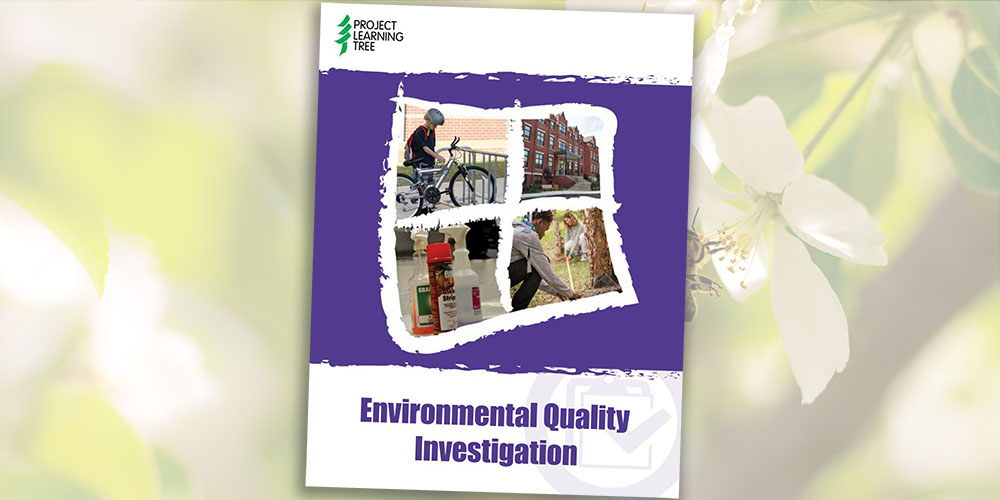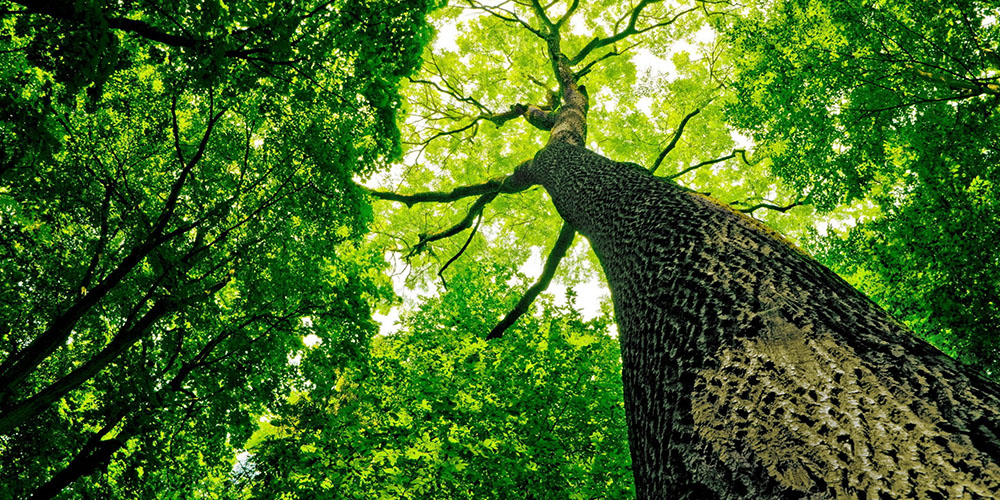Environmental Quality Investigation
Investigate Environmental Quality
Outdoor air pollution can damage human health, but many do not know that indoor air pollution can also have harmful effects. Many schools harbor pollutants that can affect the health of students and those working in the school.
Project Learning Tree’s Environmental Quality Investigation is one of five hands-on, student-driven investigations at the heart of PLT’s GreenSchools program where students investigate areas where improvements can be made in indoor air quality, transportation, chemical use, and more. The Investigation details specific things for students to measure and observe, along with student worksheets to fill out and guidance on how to combine data collected into a school-wide analysis.
PLT’s GreenSchools program inspires students to improve the environment at their school, at home, and in their community. Student-led Green Teams apply STEM (science, technology, engineering, math) to create greener and healthier schools—and save schools money!
In the Environmental Quality Investigation, students assess several aspects of the environmental quality of your school by evaluating transportation choices and hazardous materials and cleaning products used in the school. Using the data collected from the Investigation, students can develop action projects to implement in their community to make improvements.
Examples of Students’ Action Plans: Students advocate for chemical-free garden care to reduce the use of herbicides and pesticides on school grounds. They work with school administrators to encourage the use of green cleaning products. They make sure ventilation is appropriate and grow indoor plants to reduce carbon dioxide levels. They establish ‘no idling’ zones.
Visit Project Learning Tree’s website to read stories of students’ action projects. Hear from students about their green school’s journey, and from teachers about lessons they learned along the way, as well as their tips for others interested in implementing similar projects.
Get all five GreenSchools Investigations here which includes:
- Adult Leader Guide – Information on the benefits of becoming a green school, who to involve, how to form a Green Team, the steps to take to support students in conducting the Investigations, STEM connections and suggestions for additional activities to enhance each Investigation topic.
- Energy Investigation – Students investigate how much energy their school uses, the main sources of that energy, and ways to implement energy-saving strategies.
- Environmental Quality Investigation – Students investigate areas where improvements can be made in indoor air quality, transportation, chemical use, and more.
- School Site Investigation – Students investigate natural habitats, wildlife, trees, grounds maintenance practices, and ways to make improvements to their school site.
- Waste & Recycling Investigation – Students investigate how much waste their school generates and where it goes, as well as recycling and composting efforts.
- Water Investigation – Students investigate the source, cost, and quality of their school’s water supply, and ways to enhance current water conservation practices.
Testimonials
“I was amazed how the students got into these Investigations. Each day they came to class eager to find out what they needed to do next. I am so glad that we participate in the Greenschools Program.” – Katie Schlotterbeck, Science Teacher, St. Michael Lutheran School, Fort Myers, FL
“From the beginning, PLT’s GreenSchools program has helped our students grow in skills, leadership, and environmental awareness.” – Christie Hazen, Enrichment Coordinator, Two Rivers Magnet Middle School, East Hartford, CT
EE Resources
Finding Your Path
Learn more about the life of a field forester and more in this booklet Find Your Path from the Oregon Forest Resources Institute. Joe Newton, once a professional football player for the Seattle Seahawks, now works for Lone Rock Timber in Roseburg, Oregon as a Field Forester. He collaborates with tree-planters, helicopter pilots, and other... Read more »
Imagine If
Imagine If is a podcast on climate resilience. Developed by the National Association for Environmental Education and National Geographic, Imagine If interviews change-makers affecting positive change on the world. Imagine If features high school students designing solutions to environmental issues in their communities. Listen with your students and inspire them to become change-makers in their community!
Eco-Friendly Guide to Cleaning
Did you know that indoor air can be up to 100 times more polluted than outside air due to the accumulation of volatile organic compound (VOC) levels caused by chemical cleaning agents? Have students investigate the impact of common cleaning products on their environment, learn about “green cleaning,” and how to create their very own... Read more »
Funding for Greener Schools
Have you thought about trying crowdfunding to help get a GreenSchools project off the ground? Or reaching out to your community to find advocates and volunteers? The ioby (in our back yards) crowd-resourcing platform can connect you with funding and support. Whether it’s updating your school garden, adding a cafeteria composting program, or teaching students... Read more »
Healthy Indoor Air / Environmental Quality Checklist for Schools
The Coalition for Healthier Schools released a checklist to help schools implement “green cleaning” practices and to determine where improvements might be made to ensure schools inhibit mold and mildew, control dust, have fresh airflow and effective ventilation, prevent toxic fumes, and reduce chemical exposures. This checklist is part of a Green Cleaning for Healthy... Read more »
Sustainability in Schools Simulation Game
Looking for ways to bring sustainability projects to your school? Use the Sustainability in Schools Game with your middle and high school students to explore the cost-benefits. The game includes 45 cards covering a range of sustainability projects that could be implemented in your own school, along with video instructions and critical thinking questions to get your... Read more »
Managing Asthma in the School Environment
This U.S. EPA website provides information about asthma and how to control asthma triggers in schools, by promoting healthy indoor air quality.
Mold Resources
This U.S. EPA website provides facts on mold and tips for reducing mold in schools.
Mercury Releases and Spills
Old glass thermometer broke during a class experiment, now what? This U.S. EPA website provides information on how to clean up mercury spills.
U.S. Forest Service Air Quality Images
The U.S. Forest Service displays live air quality images and current air quality conditions throughout the United States, featuring real-time images.
SC3: PROTECTING STUDENTS AND STAFF WITH GREEN CLEANING
EPA’s Schools Chemical Cleanout Campaign (SC3) is working to encourage schools to use green cleaning practices to safely clean their classrooms and grounds. From elementary school maintenance closets to high school chemistry labs, schools use a variety of chemicals. Some of the most essential chemicals are those that keep schools clean and safe for students... Read more »
Safe Routes to School
The National Center for Safe Routes to School provides resources and activities that help schools identify ways to improve safety and accessibility for students walking and biking to school, as well as ways to reduce traffic and air pollution in the vicinity of schools.
School IAQ Assessment
This app, provided by the U.S. EPA, helps schools assess important issues such as ventilation, cleaning and maintenance, environmental asthma triggers, radon, and integrated pest management.
Job Corps Green Jobs
A “Green Jobs” curriculum and activity guide funded by the U.S. Department of Agriculture, Forest Service, National Job Corps Office, and the Conservation Education Program.
U.S. EPA CFL Bulb Facts
The U.S. EPA website provides specific information on the use and the proper disposal of fluorescent light bulbs. Fluorescent light bulbs must be properly disposed of because they contain very small amounts of mercury. This website also includes information on comparing and choosing light bulbs.
Environmental Justice Video: Reducing Pollution through Organizing
Be inspired by the latest video in EPA’s 20th Anniversary Environmental Justice Video Series that features Penny Newman of the Center for Community Action and Environmental Justice. Penny’s 5-minute video describes the environmental justice concerns of the Inland Valley communities in Southern California, and the ways local residents are making positive changes to protect the health of... Read more »
RadTown USA
EPA’s Radiation Protection Program has launched the RadTown USA website, created to allow middle and high school students to explore radiation- where it is found and how it is used- in four different environments. The website also has Common Core supported content, including the history of radiation protection, ways to reduce exposure risk, careers in... Read more »
Why Trees? Video
As we know, trees represent more than just beautiful natural elements of our land, they also provide shade, manage water, stop erosion, protect streams, soothe the soul, clean the air, protect the quality and health of water, and attract homeowners, renters, and shoppers. Check out this Doodle Lecture created by Alabama Cooperative Extension that unveils... Read more »
EPA’s Carbon Footprint Calculator
The US Environmental Protection Agency (EPA) website provides an interactive carbon footprint calculator designed for use by students in middle or high school. The calculator begins by asking students to investigate some baseline data points, such as their average home energy usage, transportation habits, and waste disposal process. Then, the calculator offers ways impact reduction... Read more »
Login to download supporting materials such as appendices and teaching tips.
Login
 Get this Guide
Get this Guide
 Find Training
Find Training

